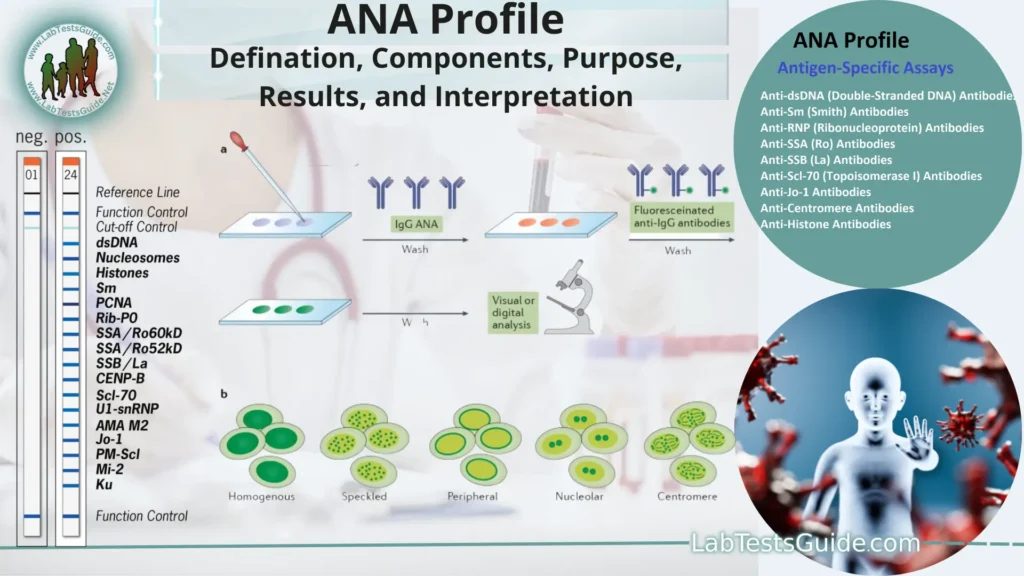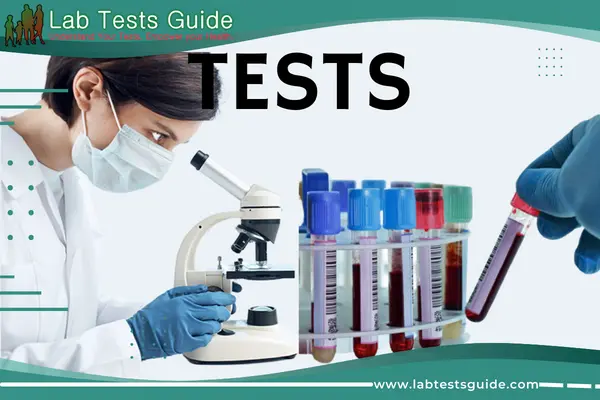The ANA Profile is a comprehensive blood test used to detect antinuclear antibodies (ANAs), which are associated with autoimmune disorders like lupus and rheumatoid arthritis. This profile includes an Indirect Immunofluorescence (IIF) assay and Antigen-Specific assays to identify specific antibody targets. Pre-sample preparation involves no dietary restrictions, and a small blood sample is required. The technique involves fluorescence microscopy and antigen-specific assays. Proper sample handling, storage, and stability are crucial for accurate results. ANA profiling aids in diagnosing and monitoring autoimmune diseases, guiding treatment decisions.

Alternative Names: ANA, Fluorescent Antinuclear Antibody, FANA, Antinuclear Antibody Screen, ANA Panel, Autoimmune Profile, ANA Comprehensive Panel, Autoantibody Profile
| Aspect | Information |
|---|---|
| Test | Antinuclear Antibodies (ANA) Testing |
| Definition | ANA testing detects antibodies targeting components of cell nuclei, often associated with autoimmune diseases. |
| Purpose | – Diagnosis and monitoring of autoimmune disorders (e.g., systemic lupus erythematosus, Sjögren’s syndrome, scleroderma). – Determining disease activity and guiding treatment decisions. |
| Test Components | – Indirect Immunofluorescence (IIF) Assay. – Antigen-Specific Assays (anti-dsDNA, anti-Sm, anti-RNP, etc.). – Titration of ANA. |
| Pre-Sample Preparation | No specific dietary or medication restrictions. Provide accurate medical history and medications. |
| Sample Required | Blood (serum or plasma). |
| Test Technique | 1. Indirect Immunofluorescence (IIF) Assay: Blood exposed to cultured cells with fluorescent patterns. Detects ANAs based on fluorescence under a microscope. 2. Antigen-Specific Assays: ELISA or similar techniques to detect specific antibodies (anti-dsDNA, anti-Sm, etc.). Qualitative or quantitative results. 3. Titration: Measurement of ANA titer to assess antibody concentration. |
| Sample Separation | – Allow blood to clot for 30 minutes. – Centrifuge to separate serum/plasma. |
| Sample Storage | – Store separated serum/plasma at 2-8°C (36-46°F). |
| Stability Requirements | – Unprocessed whole blood: Short-term room temperature storage. – Separated serum/plasma: Stable at 2-8°C for several days (up to 7 days). – Long-term storage: Freeze at -20°C (-4°F) or lower (avoid if possible due to potential antibody instability upon thawing). |
Definition of ANA Profile:
The ANA Profile is a blood test that detects antinuclear antibodies, crucial markers for autoimmune diseases like lupus and rheumatoid arthritis.
Purpose of ANA Profile:
The purpose of the ANA Profile is to identify antinuclear antibodies in the blood, aiding in the diagnosis and monitoring of autoimmune diseases such as lupus and rheumatoid arthritis.
- Diagnosis: The ANA Profile helps diagnose autoimmune disorders like systemic lupus erythematosus (SLE), rheumatoid arthritis, and Sjögren’s syndrome by detecting the presence of antinuclear antibodies.
- Disease Monitoring: It is used to monitor the progression and activity of autoimmune diseases over time, assisting healthcare professionals in making informed treatment decisions.
- Guiding Treatment: The results from the ANA Profile can guide medical interventions, helping healthcare providers tailor treatment plans to address the specific autoimmune condition.
- Early Detection: The profile aids in identifying autoimmune diseases at an early stage, enabling timely medical intervention and management.
- Assessment of Disease Severity: The ANA Profile results can provide insights into the severity of autoimmune diseases, helping doctors determine appropriate therapies.
- Differential Diagnosis: It assists in distinguishing between different autoimmune and non-autoimmune conditions, aiding in reaching accurate diagnoses.
- Research: The ANA Profile is also used in research settings to study the underlying mechanisms of autoimmune diseases and to develop new treatment strategies.
- Confirmation of Diagnosis: In cases where clinical symptoms are ambiguous, the ANA Profile can help confirm the presence of an autoimmune disease.
- Evaluation of Remission: It can be used to assess if an autoimmune disease has gone into remission, indicating a reduction in disease activity.
- Screening: In certain cases, the ANA Profile is used for initial screening, especially when there are clinical indications of autoimmune disorders.
Components of the ANA Profile:
The ANA (Antinuclear Antibodies) Profile consists of several components that collectively provide insights into the presence and patterns of antibodies targeting components of cell nuclei. Here are the main components of the ANA Profile:
- Indirect Immunofluorescence (IIF) Assay:
- This is the primary screening test and involves exposing the patient’s blood sample to cultured cells with fluorescent-labeled antibodies.
- It helps identify the presence of ANAs and provides information about the characteristic fluorescent pattern that these antibodies create within the cell nucleus.
- Antigen-Specific Assays:
- These assays are used to identify specific antibodies targeting particular components of the cell nucleus. Some common antigen-specific assays include:
- Anti-dsDNA (Double-Stranded DNA) Antibodies
- Anti-Sm (Smith) Antibodies
- Anti-RNP (Ribonucleoprotein) Antibodies
- Anti-SSA (Ro) and Anti-SSB (La) Antibodies
- Anti-Scl-70 (Topoisomerase I) Antibodies
- Anti-Jo-1 Antibodies
- Anti-Centromere Antibodies
- Anti-Histone Antibodies
- These specific antibodies are associated with distinct autoimmune diseases and can provide valuable diagnostic information.
- These assays are used to identify specific antibodies targeting particular components of the cell nucleus. Some common antigen-specific assays include:
- Titration of ANA:
- This component involves measuring the concentration of ANAs in the blood sample, often reported as an antibody titer.
- A higher titer may indicate a greater likelihood of an autoimmune condition, although the specific titer level for diagnosis varies.
Clinical Applications of ANA Testing:
ANA (Antinuclear Antibodies) testing has several important clinical applications in the field of autoimmune diseases and related conditions. Here are some key clinical applications of ANA testing:
- Diagnosis of Autoimmune Diseases:
- ANA testing is commonly used as a screening tool to help diagnose autoimmune diseases such as systemic lupus erythematosus (SLE), rheumatoid arthritis, Sjögren’s syndrome, and systemic sclerosis (scleroderma).
- The presence of specific antinuclear antibodies can help confirm the diagnosis and guide further evaluation.
- Disease Monitoring:
- ANA testing is used to monitor the progression and activity of autoimmune diseases over time.
- Changes in ANA titers and patterns can provide insights into disease flares or remission.
- Assessment of Disease Severity:
- ANA results, along with clinical symptoms and other tests, can help healthcare providers assess the severity of autoimmune diseases and tailor treatment plans accordingly.
- Guiding Treatment Decisions:
- ANA testing results can influence treatment decisions by providing information about disease activity and potential therapeutic approaches.
- Confirmation of Diagnosis:
- In cases where clinical symptoms are unclear or overlap with other conditions, ANA testing can help confirm or rule out specific autoimmune diseases.
- Early Detection:
- ANA testing can identify autoantibodies at an early stage, allowing for prompt intervention and management.
- Differentiation of Autoimmune Disorders:
- Different patterns of ANA fluorescence and specific antibody profiles can aid in differentiating between various autoimmune disorders.
- Monitoring Treatment Efficacy:
- ANA testing can help assess the effectiveness of treatment strategies over time.
- Risk Assessment:
- Positive ANA results in certain populations (e.g., close relatives of patients with autoimmune diseases) can indicate an increased risk of developing autoimmune conditions.
- Research and Discovery:
- ANA testing is utilized in research to understand the mechanisms of autoimmune diseases, develop new diagnostic tools, and explore potential therapeutic targets.
- Screening in Specific Populations:
- ANA testing might be used as part of screening protocols for individuals with certain risk factors or symptoms suggestive of autoimmune disorders.
Sample Required:
| Aspect | Information |
|---|---|
| Pre-Sample Requirements | No specific dietary or medication restrictions. |
| Specimen Type | Blood (serum or plasma). |
| Volume | 1-2 milliliters (mL) of blood. |
| Minimum Volume | Approximately 0.5 mL (may vary by laboratory). |
| Sample Container | Sterile, leak-proof serum separator tube (SST) or red-top tube. |
| Sample Separation and Transport | Allow clotting for 30 minutes, then centrifuge to separate serum/plasma. Transfer to labeled transport vial. |
| Sample Storage | Store separated serum/plasma at 2-8°C (36-46°F). |
| Stability Requirements | – Unprocessed whole blood: Short-term room temperature storage. – Separated serum/plasma: Stable at 2-8°C for several days (up to 7 days). – Long-term storage: Freeze at -20°C (-4°F) or lower (avoid if possible due to potential antibody instability upon thawing). |
Test Procedures:
The test procedures for ANA (Antinuclear Antibodies) testing involve multiple steps, including sample collection, laboratory analysis, and result interpretation. Here’s an overview of the typical test procedures:
- Sample Collection:
- A healthcare professional collects a blood sample from the patient. The sample is usually collected from a vein in the arm using a syringe or needle.
- Sample Preparation:
- The collected blood sample is processed to separate the serum or plasma, which contains the antibodies, from the blood cells.
- Indirect Immunofluorescence (IIF) Assay:
- A portion of the serum or plasma is used for the IIF assay.
- The serum or plasma is exposed to cultured cells with fluorescent-labeled antibodies that bind to antinuclear antibodies in the sample.
- The fluorescence patterns created in the cell nuclei are observed under a fluorescence microscope.
- The patterns seen help identify potential autoimmune conditions and provide preliminary information about the antibodies present.
- Antigen-Specific Assays:
- If the IIF assay indicates the presence of antinuclear antibodies, further testing may be performed to identify specific antibody targets using antigen-specific assays.
- These assays use techniques like ELISA (enzyme-linked immunosorbent assay) to detect specific antibodies, such as anti-dsDNA, anti-Sm, anti-RNP, etc.
- Titration:
- In some cases, the concentration of ANAs in the blood may be quantified, which is referred to as titration.
- The titer value indicates the dilution factor at which antibodies are still detectable.
- Result Reporting:
- The laboratory generates a report that includes information about the ANA test results, including the fluorescence patterns observed in the IIF assay, the presence of specific antibodies, and any quantitative values (such as titer levels).
- Result Interpretation:
- A medical professional interprets the test results in the context of the patient’s medical history, clinical symptoms, and other diagnostic findings.
- Patterns observed in the IIF assay and the presence of specific antibodies help guide diagnosis and treatment decisions.
- Clinical Consultation:
- The healthcare provider discusses the test results with the patient, explaining the implications and potential next steps, such as further testing or treatment.
ANA Profile Normal Values:
| Test | Normal Value |
|---|---|
| ANA (Qualitative) | Negative : titers (1:20, 1:40, 1:80) Positive: Titers (1:160, 1:320, and 1:640) |
| ANA (Quentitative) | Negative: 1.1-2.9 U Week Positive: 3.0-5.9 U Stronge Positive: ≥ 6.0 U |
| Anti-dsDNA | Negative/Normal: < 30 IU/mL |
| Anti-Sm | Normal/Negative: < 20 U/mL. |
| Anti-RNP | Normal/Negative: < 20 U/mL. |
| Anti-SSA | Normal/Negative: < 20 U/mL. |
| Anti-SCL-70 | Normal/Negative: < 20 U/mL. |
| Anti-JO-1 | Normal/Negative: < 20 U/mL. |
| Anti-Centromere Antibodies | Normal/Negative: < 30 U/mL. |
| Anti-Histone Antibodies | Negative: <1.0 units Weak Positive: 1.0−1.5 units Positive: 1.6−2.5 units |
Clinical Significance and Interpretation:
- Presence of ANAs:
- A positive ANA result indicates the presence of antinuclear antibodies in the patient’s blood.
- However, a positive result does not necessarily mean the patient has an autoimmune disease. ANAs can also be found in healthy individuals and those with infections or other non-autoimmune conditions.
- Fluorescence Patterns (IIF Assay):
- The specific patterns observed in the Indirect Immunofluorescence (IIF) assay provide initial clues about the potential underlying autoimmune condition.
- Different patterns, such as homogeneous, speckled, nucleolar, etc., can suggest different types of autoimmune diseases.
- Antigen-Specific Antibodies:
- The presence of specific antibodies, such as anti-dsDNA, anti-Sm, anti-RNP, etc., helps narrow down the potential autoimmune diagnosis.
- Certain specific antibodies are strongly associated with particular autoimmune diseases. For example, anti-dsDNA antibodies are linked to systemic lupus erythematosus (SLE).
- Clinical Symptoms and History:
- The healthcare provider considers the patient’s medical history, current symptoms, and physical examination findings.
- A thorough assessment helps determine if the observed antibodies and patterns align with a suspected autoimmune disease.
- Diagnostic Criteria:
- ANA results contribute to the fulfillment of diagnostic criteria for various autoimmune diseases, especially when combined with clinical criteria and other relevant tests.
- Pattern and Specific Antibody Correlation:
- Sometimes, the combination of a specific pattern and certain antibodies (e.g., speckled pattern with anti-RNP antibodies) strongly indicates a particular autoimmune disorder.
- Follow-Up Testing:
- Depending on the initial results, further testing might be recommended to confirm a diagnosis or rule out other possibilities.
- Additional tests, such as imaging, biopsies, and specific autoantibody tests, can provide more information.
- Ongoing Monitoring:
- For individuals with known autoimmune diseases, ANA testing may be used to monitor disease activity and treatment effectiveness.
Limitations and Considerations:
ANA (Antinuclear Antibodies) testing is a valuable tool in diagnosing and managing autoimmune diseases, but it has limitations and considerations that should be taken into account when interpreting results. Here are some important limitations and considerations:
- False Positives and Negatives:
- ANA testing can yield false positives or negatives due to various factors, including infections, medications, age, and technical issues.
- Positive results do not always indicate an autoimmune disease, and negative results do not rule out an autoimmune condition.
- Low Specificity:
- ANA positivity is not specific to a single autoimmune disease; it can be found in various conditions and even in healthy individuals.
- Clinical Correlation Needed:
- ANA results should always be interpreted alongside the patient’s clinical symptoms, medical history, and physical examination.
- Pattern Interpretation:
- While ANA patterns can suggest certain conditions, a single pattern is not exclusive to a particular disease.
- Titers and Disease Activity:
- Higher titers may correlate with disease activity, but this relationship is not linear for all autoimmune diseases.
- Different Assay Methods:
- Different laboratories may use varied testing methods and reference ranges, leading to differences in reported results.
- Non-Autoimmune Conditions:
- ANA positivity can occur in non-autoimmune conditions, such as infections or chronic inflammatory disorders.
- Age and Medications:
- Some medications and advanced age can lead to ANA positivity without underlying autoimmune disease.
- Variability Over Time:
- ANA levels and patterns can change over time, even in the absence of disease progression.
- Diagnostic Criteria:
- ANA results are part of a broader set of diagnostic criteria for autoimmune diseases.
- Additional Testing:
- Further diagnostic tests (antigen-specific assays, imaging, biopsies) are often necessary for definitive diagnosis.
- Follow-up Testing:
- Positive ANA results may require monitoring and repeat testing to track disease activity and response to treatment.
- Expert Interpretation:
- ANA testing should be interpreted by healthcare professionals with expertise in autoimmune diseases, such as rheumatologists or immunologists.
- No Standalone Diagnosis:
- ANA testing alone is insufficient to diagnose an autoimmune disease; it is part of a comprehensive diagnostic process.
FAQs:
Q: What are ANAs?
ANAs, or Antinuclear Antibodies, are antibodies that target components within the cell nucleus, often associated with autoimmune diseases.
Q: Why is ANA testing performed?
ANA testing helps diagnose and monitor autoimmune diseases like lupus, rheumatoid arthritis, and others.
Q: What is the ANA profile?
The ANA profile includes various tests to detect ANAs, such as the Indirect Immunofluorescence (IIF) assay and antigen-specific assays (Anti-dsDNA Antibodies, Anti-Sm Antibodies, Anti-RNP Antibodies, Anti-SSA (Ro) and Anti-SSB (La) Antibodies, Anti-Scl-70 (Topoisomerase I) Antibodies, Anti-Jo-1 Antibodies, Anti-Centromere Antibodies, Anti-Histone Antibodies).
Q: Are positive ANA results always indicative of autoimmune disease?
No, positive ANA results can be found in healthy individuals and non-autoimmune conditions. Clinical context is vital for interpretation.
Q: What does ANA titer mean?
ANA titer reflects the dilution factor of the patient’s serum. Higher titers can suggest higher antibody levels.
Q: Can ANA patterns diagnose specific diseases?
ANA patterns offer clues to potential diseases, but a single pattern doesn’t confirm a diagnosis.
Q: Are there specific reference ranges for ANA titers?
Yes, but they vary among laboratories. Generally, 1:40 or lower is considered normal, while 1:80 or higher might be positive.
Q: How are antigen-specific assays used in ANA testing?
These assays detect specific antibodies like anti-dsDNA, anti-Sm, etc., associated with certain autoimmune diseases.
Q: What’s the significance of anti-dsDNA antibodies?
Anti-dsDNA antibodies are strongly linked to lupus. Elevated levels can suggest lupus or other autoimmune conditions.
Q: Can medications affect ANA results?
Yes, certain medications can cause false-positive ANA results.
Q: Is ANA testing the only step in diagnosing autoimmune diseases?
No, ANA testing is part of a comprehensive diagnostic process that includes clinical evaluation and other tests.
Q: What if I have a positive ANA result but no symptoms?
ANA positivity without symptoms might not require immediate treatment. Monitoring and follow-up are often recommended.
Q: Can ANA results change over time?
Yes, ANA levels and patterns can vary over time, even without disease progression.
Q: Can ANA tests predict disease severity?
Higher ANA titers can correlate with disease activity, but this isn’t true for all autoimmune diseases.
Q: Are ANA tests used for research purposes?
Yes, ANA testing aids in understanding autoimmune mechanisms and exploring potential treatments.
Q: Should I see a specialist for ANA interpretation?
Yes, consult a rheumatologist or immunologist with expertise in autoimmune diseases for accurate interpretation.
Q: Is a positive ANA test a definite diagnosis of lupus?
No, a positive ANA test is part of lupus diagnosis criteria, but it isn’t sufficient on its own.
Conclusion:
In conclusion, ANA (Antinuclear Antibodies) testing is a valuable tool in the diagnosis and monitoring of autoimmune diseases, providing insights into potential underlying conditions. While positive results can raise concerns, they require careful interpretation within the context of the patient’s clinical presentation, medical history, and other diagnostic findings. ANA patterns, antigen-specific assays, and titer levels collectively contribute to the diagnostic puzzle, guiding healthcare professionals in making accurate diagnoses and tailored treatment decisions. Expert evaluation by rheumatologists or immunologists is essential to ensure precise interpretation and appropriate management, recognizing the complexity of ANA testing in the broader realm of autoimmune disorders.
Possible References Used





